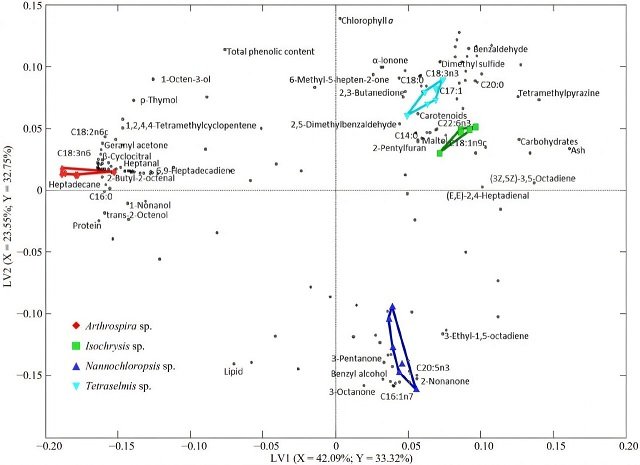
Microalgae are gaining significant attention as a sustainable and nutrient-rich alternative to traditional food sources. Their rapid growth rate, high nutritional value, and versatility make them promising candidates for various applications in the food and pharmaceutical industries.
A recent study published by scientists from the University of Otago, the Riddet Institute, and the University of the Philippines Visayas delved into the chemical, microstructural, rheological, and volatile flavor properties of four microalgae species: Arthrospira, Isochrysis, Nannochloropsis, and Tetraselmis. By employing advanced chemometric techniques, the researchers were able to identify distinctive features that set these species apart.
Multiplatform Analytical Approach
To better understand the properties of microalgae, the researchers employed a multiplatform analytical approach. This approach integrated untargeted identification and targeted profiling with chemometric data analysis.
According to the study published in the journal Food Innovation and Advances, the scientists used advanced chemometrics to integrate proximal composition, microstructural and rheological properties, with attributes related to volatile flavor. This enabled the determination of unique and discriminant markers that reflect the distinctive characteristics of each microalgae species.
Chemical Composition and Functional Properties
Microalgae are rich in macronutrients, including proteins, vitamins, antioxidants, and fatty acids, making them a valuable source of nutrition. The chemical composition of microalgae varies by species, with some species rich in specific bioactive compounds.
The nutrient profiles of the microalgae can be summarized as follows:
- Arthrospira: Showed the highest protein content (57.92%), significantly related to its abundant water-soluble phycobiliproteins, making it a valuable source of essential amino acids.
- Nannochloropsis: Rich in lipids, particularly polyunsaturated fatty acids (PUFA), known for their numerous health benefits.
- Isochrysis: Abundant in carotenoids and total phenolics, potent antioxidants that can protect cells from oxidative damage; it also has a high ash content (38.55%).
- Tetraselmis: High in carbohydrates (25.42%), providing a readily available energy source.
Microstructural and Rheological Properties
The microstructural and rheological properties of microalgae are also important factors to consider in food applications. These properties can affect the texture and structure of food products, as well as their nutritional value. For example, Nannochloropsis sp. has been shown to significantly impact dough color, while Tetraselmis sp. has favorable emulsifying and foaming properties.
The researchers reported that:
Stay Always Informed
Join our communities to instantly receive the most important news, reports, and analysis from the aquaculture industry.
- Arthrospira and Isochrysis exhibited high viscosity and thickening potential, making them suitable as food thickeners and stabilizers.
Volatile Flavor Attributes
In addition to their chemical composition and functional properties, microalgae also possess unique volatile flavor attributes. These attributes can influence the taste and aroma of food products, making microalgae a promising ingredient for developing new food products. For instance, Arthrospira sp. has a distinctive flavor profile, while Isochrysis sp. has been shown to contain high levels of volatile compounds.
According to the study results, the volatile flavor profiles are:
- Arthrospira: Characterized by aldehydes, terpenes, and hydrocarbons.
- Nannochloropsis: Dominated by ketones and alcohols.
- Tetraselmis: Rich in aldehydes, ketones, and sulfur-containing compounds.
- Isochrysis: Characterized by furans and aldehydes.
Potential Applications
The study highlights the significant diversity in the chemical composition of these microalgae, which can be influenced by factors such as cultivation conditions, geographical origin, and genetic variability. These differences point to the potential use of each species as functional ingredients in food and pharmaceutical applications, emphasizing their unique nutritional profiles.
The diverse properties of these microalgae species offer a wide range of possible applications in the food and pharmaceutical industries:
Food and Beverages:
- Nutrient-rich dietary supplements
- Functional food ingredients
- Texturizers and stabilizers
- Flavor enhancers
Pharmaceuticals:
- Nutraceuticals
- Drug delivery systems
- Cosmetics
According to the study’s lead researcher, Dr. Biniam Kebede, “Our research demonstrates the significant diversity among microalgae species in terms of their nutritional and functional characteristics. This variation opens opportunities to utilize these species in specific food products and pharmaceutical formulations, helping to address global sustainability and health challenges.”
Conclusion
In conclusion, microalgae are a promising source of functional ingredients for food applications. The chemical composition, microstructural and rheological properties, and volatile flavor attributes of microalgae vary by species, making it essential to evaluate these properties before use in the food sector.
The multiplatform analytical approach used in this study enabled the identification of unique and discriminant markers that reflect the distinctive characteristics of each microalgae species, indicating their potential as functional ingredients. Further research is needed to fully understand the potential of microalgae as functional ingredients in food applications.
Contact
Biniam Kebede
Department of Food Science, University of Otago
PO Box 56, Dunedin 9054, New Zealand
Email: biniam.kebede@otago.ac.nz
Reference (open access)
Magpusao J, Oey I, Kebede B. 2024. Chemical, rheological, and volatile profiling of microalgae Arthrospira, Isochrysis, Nannochloropsis, and Tetraselmis species. Food Innovation and Advances 3(2): 75−87 doi: 10.48130/fia-0024-0007
Editor at the digital magazine AquaHoy. He holds a degree in Aquaculture Biology from the National University of Santa (UNS) and a Master’s degree in Science and Innovation Management from the Polytechnic University of Valencia, with postgraduate diplomas in Business Innovation and Innovation Management. He possesses extensive experience in the aquaculture and fisheries sector, having led the Fisheries Innovation Unit of the National Program for Innovation in Fisheries and Aquaculture (PNIPA). He has served as a senior consultant in technology watch, an innovation project formulator and advisor, and a lecturer at UNS. He is a member of the Peruvian College of Biologists and was recognized by the World Aquaculture Society (WAS) in 2016 for his contribution to aquaculture.




